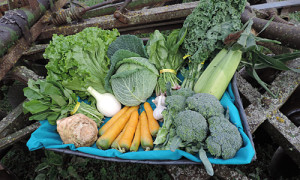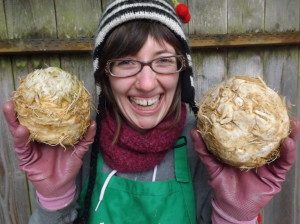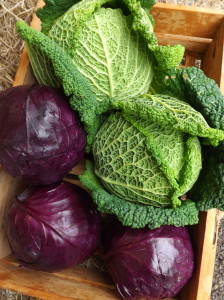Week 12, September 26
Both boxes have: Savoy cabbage, arugula, garlic, celeriac, yellow carrots, spinach, lettuce
The Small box also has: Corn
The Standard box also has: Green kale, Copra onion, broccoli
Celeriac
“You can’t tell a book by its cover” goes the proverb, and it couldn’t be more true in the case of celeriac, aka celery root. Although it looks gnarly on the outside, its luscious cream-color interior is aromatic, delicious and extremely versatile.
The celery root in your box this week is not actually the root of full sized celery. Instead, celeriac is a different variety that produces a smaller, tougher stalk on top, and is grown for its delicious softball-sized root. This long-season crop was planted in the green house early April and transplanted late May into the 24 Carrot Farm’s rich alluvial soils.
If you come from Europe, or lived there for any length of time, celeriac is no stranger to you. It has been a common cultivar there since the 17th century. Celeriere moulade, a classic cold French salad, is prepared by peeling and grating the root, then soaking it in diluted lemon juice and tossing it in a mustardy mayonnaise. A simple and delicious favorite local way to enjoy celeriac is roasted in a root medley, alongside other fall roots, such as carrots, potatoes and beets.
It’s a perfect substitute for starchier veggies, such as potatoes, and it has only 30 calories per serving. It’s also an excellent source of dietary fiber. You can boil and mash it, grill it, cut it into long strips and French‐fry it, or grate it raw on a green salad. Add it to soups, stews or casseroles. Peel it with a paring knife rather than a vegetable peeler because the outer layer can be fibrous. It’s worth every effort, because its flavor is so unique and delicate.
Savoy Cabbage
Savoy cabbage is a visually stunning vegetable with its crinkly leaves and varying hues of green and yellow. High in vitamin K, vitamin C and fiber, it’s also a very good source of manganese, folate, vitamin B6, potassium, and omega-3 fatty acids. Heads of Savoy cabbage can be so large it’s a good idea to have several dishes in mind. Because it is so tender, don’t shy away from using it in salads. Just use salt and a vinegar or lemony dressing to help it wilt.
Savoy cabbage is named for a principality on the borders of Italy, France and Switzerland. It is one of the sweetest of all the cabbages, and goes well with strong flavors, like sausages or seafood. It can be braised, roasted or boiled, and it’s very easy to saute it in butter, olive oil or bacon fat. It can also be used in preserved recipes like kimchi or sauerkraut.
Try it chopped finely in a coleslaw, or added to fresh greens for a refreshing autumn salad.
Creamy Savoy Cabbage & Carrots



